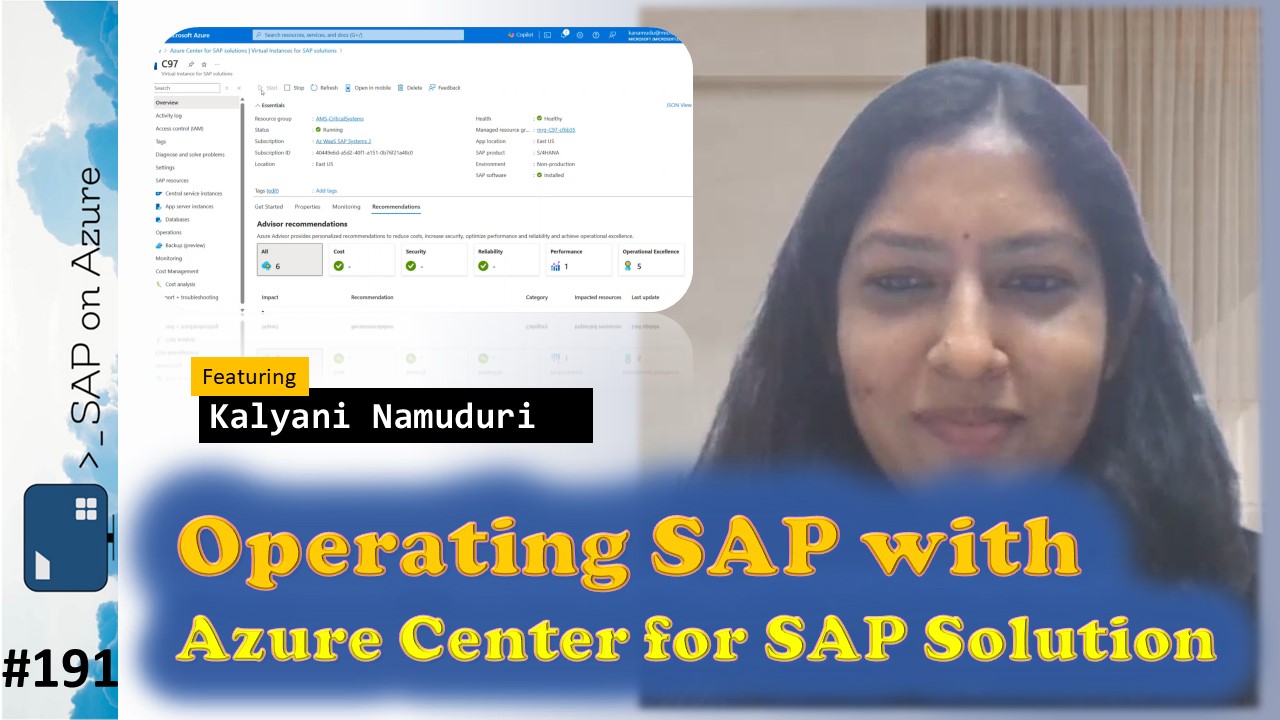Episode #191
Introduction
In episode 191 of our SAP on Azure video podcast we talk about again about Azure Center for SAP Solutions, ACSS. When running your SAP system on Azure, ACSS is here to help you create, run and operate it. In previous episodes we already looked at this in detailed and talked about some of the features available with ACSS. While we see the number of customers and registered SAP systems steadily increasing, we are also adding new features to it. To continue with our story from February where we introduced ACSS, I am happy to have Kalyani with us again to show us some more features.
Find all the links mentioned here: https://www.saponazurepodcast.de/episode191
Reach out to us for any feedback / questions:
- Robert Boban: https://www.linkedin.com/in/rboban/
- Goran Condric: https://www.linkedin.com/in/gorancondric/
- Holger Bruchelt: https://www.linkedin.com/in/holger-bruchelt/
#Microsoft #SAP #Azure #SAPonAzure #Operation
Summary created by AI
- ACSS Introduction:
Holger introduces the episode of the SAP on Azure Video podcast, focusing on the Azure Center for SAP Solutions (ACSS) and its role in aiding customers to create, run, and operate SAP systems on Azure.
- Podcast Introduction: Holger opens the SAP on Azure Video podcast episode, discussing the Azure Center for SAP Solutions (ACSS) and its assistance to customers in establishing and managing their SAP systems on Azure.
- ACSS Overview: Kalyani, a product manager at Microsoft, provides an overview of ACSS, emphasizing its comprehensive capabilities for deploying, managing, and monitoring SAP workloads on Azure.
- Customer Adoption: Holger mentions the increasing number of customers registering their SAP systems with ACSS, indicating growing adoption and interest in the service.
- Feature Enhancements: The discussion includes the continuous addition of new features to ACSS, enhancing its functionality and value for users.
- ACSS Features:
Kalyani, representing Microsoft, discusses the end-to-end experience provided by ACSS for deploying, managing, and monitoring SAP workloads on Azure, highlighting its significance for customers.
- End-to-End Experience: Kalyani elaborates on the end-to-end customer experience with ACSS, detailing its deployment, management, and monitoring capabilities for SAP workloads on Azure.
- Customer Benefits: The conversation highlights the benefits for customers using ACSS, including recommendations for optimal configurations and system management ease.
- Capability Insights: Kalyani expresses excitement about sharing the capabilities of ACSS that aid customers in operating their SAP systems efficiently.
- Start/Stop Automation:
Kalyani explains the start/stop automation feature of ACSS, which allows SAP basis admins to start and stop their systems directly from the portal or using PowerShell/CLI commands, without logging into the VM.
- Automation Feature: Kalyani demonstrates the start/stop automation feature in ACSS, enabling SAP basis admins to control their systems via the portal or command-line interfaces without accessing the VM directly.
- Operational Convenience: The feature provides convenience for admins, allowing them to execute start/stop commands easily, enhancing operational efficiency.
- Instance-Level Control: ACSS offers control at both the VIS level for SAP applications and at the instance level for central services, app servers, and databases, including HANA DB.
- API Integration: Holger appreciates the API exposure, enabling integration with existing Azure automation and control over SAP system operations through ACSS APIs.
- Role-Based Access: Kalyani discusses the role-based access control within ACSS, ensuring sensitive start/stop operations are restricted to authorized personnel.
- Snooze Capability:
Kalyani introduces the snooze capability of ACSS, which enables customers to save costs on non-production systems by scheduling them to start and stop, thus avoiding unnecessary costs.
- Cost Optimization: Kalyani presents the snooze capability as a cost-saving feature for non-production systems, allowing scheduled start/stop operations to minimize expenses.
- Operational Flexibility: The snooze feature provides flexibility for scenarios like patching weekends, enabling systematic shutdown and restart of SAP systems for maintenance.
- Automation Setup: Kalyani showcases an ARM template from the ACSS GitHub repository, which users can deploy to automate scheduled start/stop actions for their SAP systems.
- Customization Options: The ARM template offers customization options for the snooze feature, including time triggers, managed identities, and resource selection for targeted action.
- Alert Integration: The snooze automation integrates with Azure’s alert framework, allowing users to receive notifications and integrate with services like ServiceNow for ticket creation upon system stop/start events.
- Role-Based Access Control:
Kalyani emphasizes the importance of role-based access control in ACSS, allowing customers to enforce who can start and stop SAP systems, ensuring sensitive operations are restricted to authorized personnel only.
- Access Control: Kalyani highlights the role-based access control feature in ACSS, which provides customers with the ability to define permissions for starting and stopping SAP systems, ensuring only authorized users can perform these actions.
- Permission Flexibility: The discussion includes the flexibility of permissions, allowing customers to tailor access rights to specific user needs and security requirements.
- Backup Configuration:
Kalyani presents the backup configuration feature in ACSS, which simplifies the process of configuring backups for entire SAP systems, including VMs and databases, through the VIS experience.
- Backup Simplification: Kalyani introduces the backup configuration feature in ACSS, which streamlines the backup process for SAP systems, making it easier for users to secure their VMs and databases.
- Integrated Backup: The feature integrates with Azure backup services, providing a unified experience for users to manage backups within the ACSS VIS experience.
- Cost Analysis:
Kalyani highlights the cost analysis feature of ACSS, which aggregates the cost of all resources making up an SAP system and presents it at the Sid level, aiding in cost management.
- Cost Management: Kalyani discusses the cost analysis feature, which compiles the costs of all components associated with an SAP system, offering a comprehensive view of expenses at the Sid level.
- Resource Aggregation: The feature aggregates costs from various resources, such as VMs, disks, and load balancers, to provide a clear cost breakdown for SAP systems.
